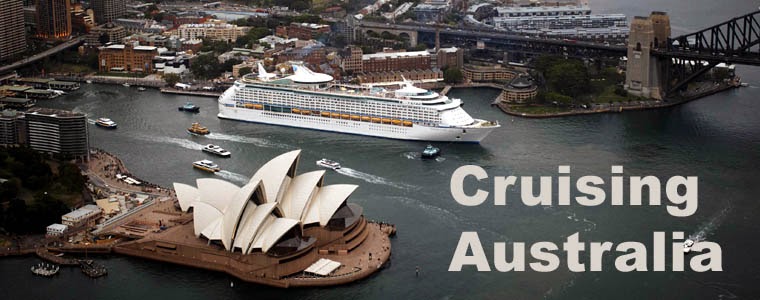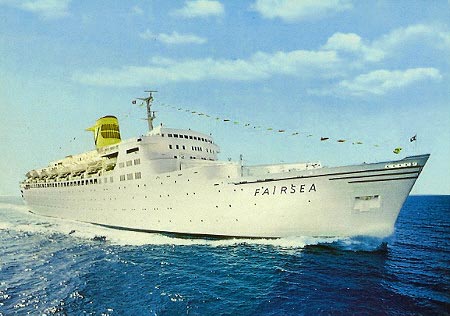 |
| Canadian Pacific’s 6,026-ton Princess Patricia (above), when chartered to Princess Cruises in 1965, gave her name to a new cruise line. |
Princess Cruises:
From its modest beginnings in 1965 with a single ship cruising to Mexico, Princess Cruises has grown to become one of the premiere cruise lines in the world. Today, its fleet carries more than a million passengers each year to more worldwide destinations than any other major line.
The most recognized cruise line in the world was catapulted to stardom in 1977 when Pacific Princess was cast in a starring role on a new television show called The Love Boat. The weekly series, which introduced millions of viewers to the still-new concept of a sea-going vacation, was an instant hit and both the company name and its "seawitch" logo have remained synonymous with cruising ever since.
Princess Cruises' modern fleet has grown considerably in recent years to include Caribbean Princess (2004), Coral Princess (2003), Dawn Princess (1997), Diamond Princess (2004), Island Princess (2003), Pacific Princess (1999), Regal Princess (1991), Royal Princess (1984), Golden Princess (2001), Grand Princess (1998), Sapphire Princess (2004), Star Princess (2002), Sun Princess (1995) and Tahitian Princess (1999). Two additional new ships will join Princess Cruises' fleet by 2007, making it one of the most modern fleets on the high seas.
Personal Choice Cruising:
Building on past success, Princess Cruises is continually evolving to meet the needs of the today's cruise passenger. In the mid-1990s the company pioneered the concept of putting passengers in control of their own cruise experience with the introduction of its Sun-class ships. These revolutionary vessels gave passengers the freedom to choose from a wide range of flexible onboard facilities, amenities and services in order to create a personal vacation experience that takes the regimentation out of the cruise experience and suits each passenger's own needs and preferences.
Today, the line's signature emphasis on Personal Choice Cruising is apparent across the fleet, with each vessel offering its own unique version on a host of multiple dining options and locations; flexible and varied entertainment selections; renowned customer service; and a full complement of onboard activities including a variety of ScholarShip@Sea enrichment classes featuring computer training, ceramics, culinary arts, finance and photography. Often copied but never duplicated, the Princess concept of cruise holiday customisation has since been adopted as the touchstone of new ship design for the entire cruise industry.
Affordable Luxury and an Abundance of Balconies:
In addition to incorporating a wide range of choices, vessels in the Princess Cruises fleet are specifically designed to provide the ultimate in affordable luxury, with an emphasis on "big ship choice with small ship feel." No matter the size of the ship, public spaces are designed to feel intimate and are decorated in a contemporary style, allowing passengers to enjoy themselves in an informal, relaxed onboard atmosphere that mirrors today's lifestyles. The company has also long been the leader in building ships specifically designed to accommodate an extensive number of the most sought-after shipboard luxury -- the private balcony. In the mid-1980s Princess pioneered the concept of the affordable veranda, once an exclusive feature incorporated in only the most expensive suites. Today, the Princess Cruises' fleet offers one of the highest percentages of balcony cabins in the industry, across all cabin categories. The physical design and décor of the ships, coupled with Princess Cruises' hallmark service excellence, creates an onboard atmosphere of relaxed luxury in which passengers can enjoy their perfect holiday experience.
 |
| Regal Princess, a Royal Class cruise ship, is the latest development from Princess Cruises |
Worldwide Destinations:
Princess Cruises' philosophy of choice is also reflected in its sailing schedule. Offering voyages to more worldwide cruise destinations than any other major line, Princess Cruises has more than 150 itineraries ranging from seven to 72 days. The line sails to all seven continents and calls at nearly 260 ports around the world. Princess Cruises passengers can enhance their cruise experience through the Adventures Ashore program featuring more than 1,500 in-port excursions worldwide, and the company's expanding cruise tour offerings enable passengers to combine their cruise with a full land tour. Destinations on all seven continents include the Caribbean, Alaska, Panama Canal, Europe, Mexican Riviera, South America, Australia/New Zealand, South Pacific, Hawaii, Tahiti/French Polynesia, Asia, India, Africa, Holy Land, Canada/New England and Antarctica.
Having led the way in Gulf of Alaska cruising, Princess Cruises maintains a strong presence in Alaska. Through its Seattle-based Princess Tours division, the company operates a wide variety of spectacular land and sea experiences in the majestic "Land of the Midnight Sun." The largest cruise and tour operator in the state, Princess Cruises operates six cruise ships, five riverside wilderness lodges, luxury Midnight Sun Express Ultra Dome rail cars, and a fleet of deluxe motor coaches; allowing cruise passengers to connect seamlessly to a landside tour and experience several distinctly unique facets of the Alaska wilderness in a single trip.
Princess Cruises is part of Carnival Corporation & PLC, one of the largest cruise holiday companies in the world.






